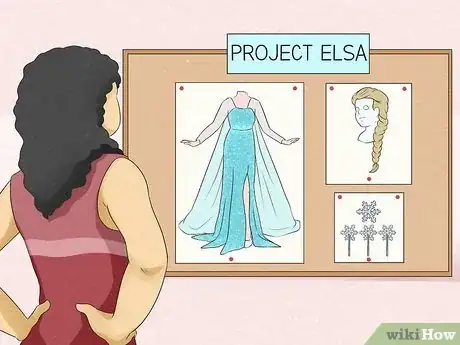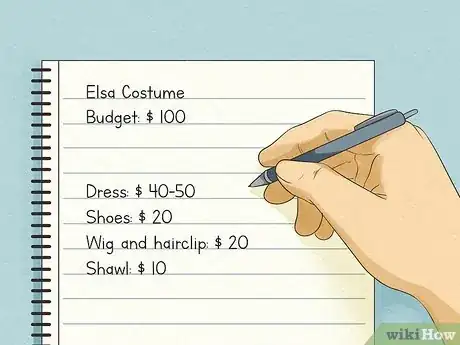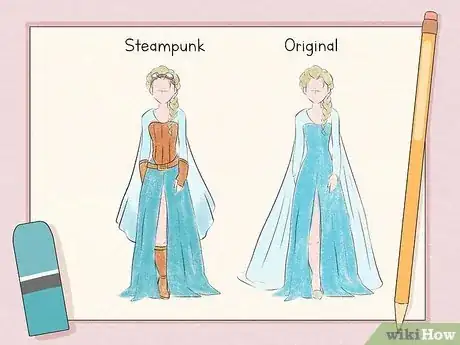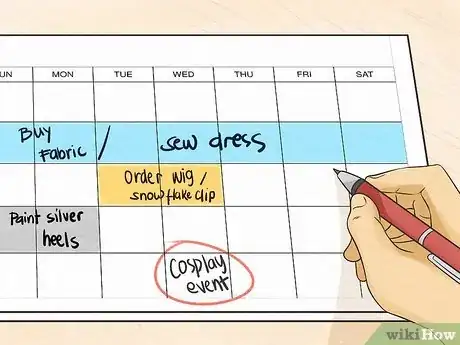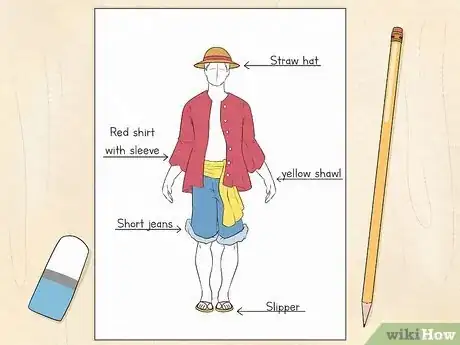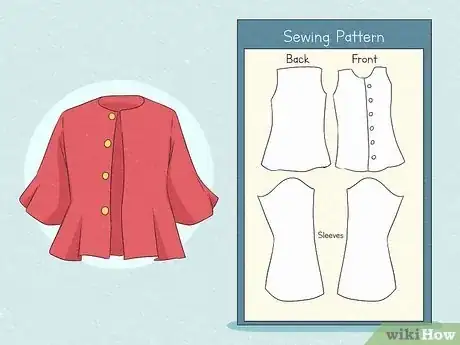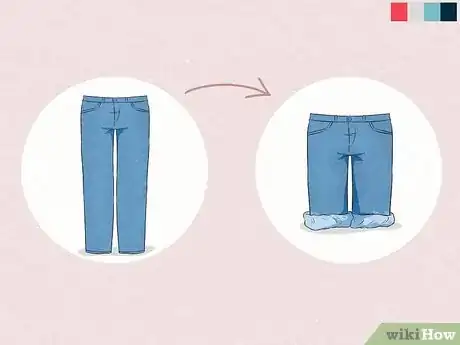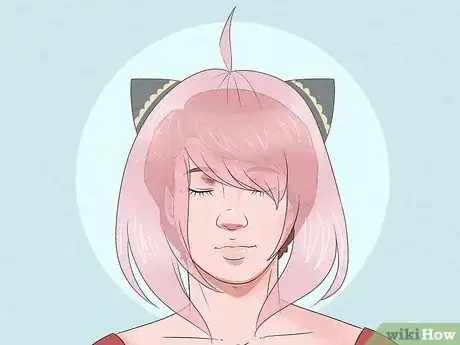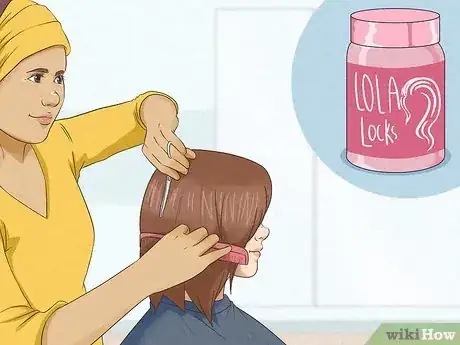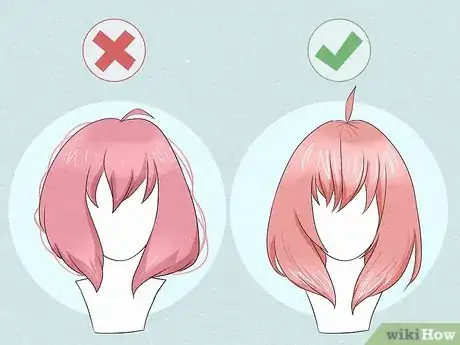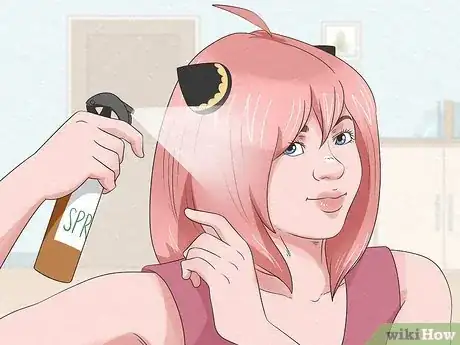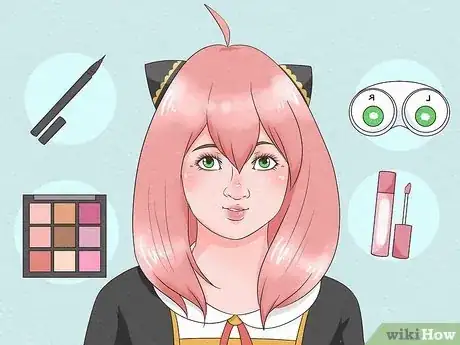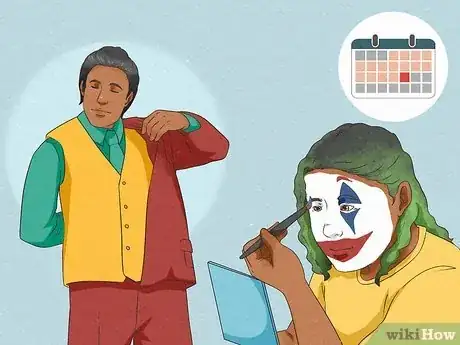This article was co-authored by Joseph Harwood. Joseph (JoJo) Harwood is a Beauty, DEI & Social Media Expert, Artist, CEO of Joseph Hartwood Ltd, and Creative Director of Team Baron Group. With over 15 years of experience, they specialize in all aspects of beauty, digital media production, and supporting diversity and inclusion efforts in businesses. JoJo has pioneered YouTube content and branding, with over 100 million views on their YouTube tutorial content and was the first and only winner of Simon Cowell's You Generation Competition. They studied an MSc in Cosmetic Science from the London College of Fashion, combining a technical understanding of cosmetics with beauty expertise.
wikiHow marks an article as reader-approved once it receives enough positive feedback. This article received 13 testimonials and 83% of readers who voted found it helpful, earning it our reader-approved status.
This article has been viewed 565,823 times.
Cosplaying is a lot of work, whether you choose to make, commission, or buy your cosplay. You need to spend a lot of time researching and putting together your cosplay. Once you have it finished, you still need to add the details, such as hair and makeup. Having a few poses in mind and knowing how to get into character would also be a good idea. Despite all of this work, cosplaying is fun, and the effort is worth it.
Steps
Planning Your Cosplay
-
1Decide who you want to cosplay. Choose a character you can relate to or that you are similar to. Keep in mind that you don't have to cosplay as your race, body type, or gender; anyone can cosplay. On a similar note, your cosplay does not have to be from anime or anything of Japanese origin. You can cosplay a character from a movie, television show, or even a western animation (e.g., Disney).[1]
- If this is your first time cosplaying, however you may want to choose a character with a simpler design.
-
2Get reference pictures. Don't just get any reference pictures, however; get the ones of the specific version of the character you are dressing up as. Many characters have multiple outfits. Some characters' costumes change slightly from film to film. For example, Iron Man's body suit changes a little in each Iron Man and Avengers film. Batman spots a different design with each film as well.
- This may not be possible with fan art. In this case, get the best quality image of the fan art you are basing your cosplay on.
Advertisement -
3Determine how much money and effort you are willing to put into your cosplay. You don't need to spend a lot of money in order to have a great-looking cosplay. If you want your cosplay to look great for cheap, however, be prepared to spend lots of time on it. Some cosplays will also require more than just sewing, such as casting parts in resin or making foam armor.
- The more time you have before the event, the more elaborate you can make your cosplay. If the event is this weekend, consider something simpler.
-
4Design your own cosplay if you want to be more original. You can always go with a screen-accurate version of the character you are cosplaying. Alternatively, you can put a unique spin on it, such as a historically-accurate version of a Disney princess, or a steampunk version of a character. You can even do a crossover between two costumes, such as a Sailor Scout version of a Pokemon.
- Look at pictures of other people's cosplays or fan art for inspiration.
- If you decide to base your cosplay off of someone's fan art, ask the artist for permission. It's the polite thing to do.
-
5Plan ahead and give yourself time to finish your cosplay. Even if you are buying your cosplay, you still need to account the time it takes to create it (if you are commissioning someone to make it) and the time it takes to ship it out. If you are making the cosplay, you might want to give yourself extra time to fix any mistakes.
- The more difficult and detailed the costume is, the more time you'll need to make it.
Making or Buying Your Cosplay
-
1Make a list of everything you need. This includes every piece of the entire outfit, down to the belt, gloves, and shoes. It should also include things like wigs (if you are using one), makeup, and any necessary undergarments. If you are going to make the cosplay, write down the materials you'll need for each piece. For example:
- White blouse: white cotton, white thread, white buttons
- Green skirt: dark green twill or wool suiting, matching thread, zipper, hook closure
- brown loafers, white knee socks, skin-toned bra
-
2Use patterns when sewing your cosplay. You can buy a pattern from the fabric store or draft your own. If you decide to use store-bought patterns, be prepared to modify them to suit the character and your figure. Many patterns also include a list of recommended fabric types. Take these into consideration!
- You may need to change the shape of the hem or sleeves on the pattern.
- If a pattern is the right shape but the wrong length, you'll need to add/subtract length to/from it.
- Don't be afraid to change the shape of a collar to suit your cosplay.
-
3Don't be afraid or ashamed to buy pieces for your cosplay. You don't have to make everything from scratch. If your cosplay requires an everyday item, it would be easier to just buy it.[2] For example, if you are cosplaying Kagome from Inuyasha, it would be much cheaper, easier, and faster to buy a pair of knee socks rather than make them yourself.
-
4Consider buying and modifying piece to suit your cosplay. Sometimes, you may come across an item that is the right shape, but the wrong color. Other times, you may come across something that is the right color but a little too long. Instead of making a whole new piece, get the almost-right piece, then modify it.[3] For example:
- If something is the right shape but the wrong color, dye it.
- If something is too long or has sleeves, cut it. Don't forget to hem it though (if needed).
- Paint boots to match your cosplay, or make boot covers for them.
-
5Do your research when buying or commissioning a cosplay. There is no guarantee that the cosplay will fit you perfectly, especially if you buy it from a cosplay shop. The quality may be top-notch, or it may be sub-par. Most importantly, research the company or the person you are buying or commissioning the cosplay from. Make sure that they are reliable!
-
6Don't forget the props and accessories. While not absolutely necessary, they can really take your cosplay to the next level. A prop can help you come up with more creative poses, while accessories can make your cosplay more realistic. As with the rest of your cosplay, you can make, buy, or commission your props and accessories.
- Many animated films use simple designs. If you are cosplaying as a Disney princess, consider adding some jewelry or hair pieces!
- Read the convention's rules regarding props to find out what is and what isn't allowed.
Doing Your Hair and Makeup
-
1Plan out your look. As with the costume, think about how the character's hair and makeup would translate into real life. Can you get away with using your real hair, or will you need to get a wig? Makeup will help you look better in photos, but do you want a more stylized or a more realistic look? Take a moment to think about what sort of look you are going for.
-
2Use your own hair if you are willing to cut it or dye it. If your hair is almost right for the character, but not quite, don't be afraid to straighten it, curl it, or add extensions. If you are more daring, you can even dye your hair or cut it to better suit the character. Only do this if you actually like the style, however; you'll be stuck with it for a few months.[4]
-
3Use a high-quality wig if you don't want to mess with your real hair. For the best look, purchase a high-quality wig from a reputable wig or costume shop; avoid using the cheap wigs from the party or Halloween store. If you want your cosplay to look even more realistic, you can get a lace-front wig instead.[5]
- Wear a wig cap under the wig, which both covers up and conceals the color of your natural hair.
- Use bobby pins that keep your wig in place. Make sure that they match the wig color.
- Pin your hair up under the wig. You don't want it sticking out under the wig. If you've got very long hair, try doing two braids in a center part. Then, fold the braids up against each other to make the top of your head flat (and to put your hair at the back of your head).
-
4Style your hair or the wig. Whether you are using your own hair or a wig, you'll need to style it. Most wigs rarely look like the intended character's hair, so you'll likely need to trim it; in some cases, you'll need to straighten it or curl it. You will also need to comb your hair or the wig into the right style, then set it with hairspray.
- Use hairspray and styling wax to shape your hair.
- If you are styling a wig, invest in a Styrofoam wig head.
- Teasing is an effective method that can be used to create a spike or add volume.
- Do not use curling irons or flat irons on wigs that are not heat safe. When in doubt, use the hot water curling or straightening method.
-
5Wear makeup. Makeup is important for cosplay. It makes your skin appear smoother and more photogenic. For most characters, you will need a natural look: basic foundation, neutral eyeshadow, and eyeliner. If you are cosplaying a feminine character, you can add mascara or false lashes. From there, you can bring more life to your character with lipstick and contouring or blush.[6]
- You can use contouring to make your face look more feminine or masculine.
- Even male characters can benefit from lipstick. Use a neutral color.
- You can use a different color of eyeshadow, but only if it suits the character and costume.
Putting the Cosplay into Play
-
1Practice getting into cosplay before the big event. This includes applying the makeup, putting the wig on, putting in and taking out contact lenses, etc. If something doesn't fit or feel comfortable, take a moment to fix it. Make sure that your cosplay is comfortable and durable.[7]
- If you are having troubles with contact lenses, leave them out. Don't leave costume contact lenses in your eyes for the entire convention; that is asking for a serious infection.
-
2Get into character. You don't necessarily have to act like your character, although you can if you want to. It would be a good idea to have some poses in mind, however. People love to take pictures of other people's cosplays at conventions, so there is a high chance that someone might want to take a picture of yours![8]
-
3Be respectful of other people's boundaries. There is nothing wrong with getting into character if you see someone from the same anime or series. Be aware that not everyone will want to play along with you. If they don't play along, apologize and leave them alone; don't harass them or force them to play with you.
-
4Try not to take things too seriously. Cosplay is supposed to be fun. Instead of comparing yourself to everyone else, feel proud of the work you did. Meet up with friends or make new ones. If you are shy, consider going to some panels, gathering, or other events. There is lots to do at conventions while in cosplay![9]
- If you do like competition, consider joining the cosplay contest or masquerade; most conventions will have one.
-
5Remember that cosplay is not consent. If someone makes you feel uncomfortable, speak up. Report them to security or con-ops. If someone is harassing you, and con-ops or security are not around, call for help. While these instances are not common at conventions, they still happen. Your safety is very important.[10]
- Stay smart. Don't go to empty or solitary places with people you don't know.
- Stick with a friend or a person you trust, especially if you are out at night.
Expert Q&A
-
QuestionHow do you get a lace front wig to stay on?
 Joseph HarwoodJoseph (JoJo) Harwood is a Beauty, DEI & Social Media Expert, Artist, CEO of Joseph Hartwood Ltd, and Creative Director of Team Baron Group. With over 15 years of experience, they specialize in all aspects of beauty, digital media production, and supporting diversity and inclusion efforts in businesses. JoJo has pioneered YouTube content and branding, with over 100 million views on their YouTube tutorial content and was the first and only winner of Simon Cowell's You Generation Competition. They studied an MSc in Cosmetic Science from the London College of Fashion, combining a technical understanding of cosmetics with beauty expertise.
Joseph HarwoodJoseph (JoJo) Harwood is a Beauty, DEI & Social Media Expert, Artist, CEO of Joseph Hartwood Ltd, and Creative Director of Team Baron Group. With over 15 years of experience, they specialize in all aspects of beauty, digital media production, and supporting diversity and inclusion efforts in businesses. JoJo has pioneered YouTube content and branding, with over 100 million views on their YouTube tutorial content and was the first and only winner of Simon Cowell's You Generation Competition. They studied an MSc in Cosmetic Science from the London College of Fashion, combining a technical understanding of cosmetics with beauty expertise.
Beauty, DEI & Social Media Expert Use a strong, water soluble gel to stick the wig to your hairline rather than using old-fashioned latex glue. This type of glue will get stuck in the mesh/lace and destroy the fabric, which you definitely don't want.
Use a strong, water soluble gel to stick the wig to your hairline rather than using old-fashioned latex glue. This type of glue will get stuck in the mesh/lace and destroy the fabric, which you definitely don't want. -
QuestionI really want to cosplay, but I'm not sure how my mom will feel. How can I tell her?
 Community AnswerJust tell her and see how she reacts. If you don't want to be quite so direct, bring it up during a time when you're already dressed up as a character, like Halloween.
Community AnswerJust tell her and see how she reacts. If you don't want to be quite so direct, bring it up during a time when you're already dressed up as a character, like Halloween. -
QuestionIs it possible to dress as an OC at a convention?
 Community AnswerOf course! This is a great way to introduce your own characters, and it breaks the ice when people ask what your outfit is all about!
Community AnswerOf course! This is a great way to introduce your own characters, and it breaks the ice when people ask what your outfit is all about!
Warnings
- Don't be afraid to say "no" if someone wants to take your picture. Be polite about it, however.⧼thumbs_response⧽
- Don't procrastinate or wait until the last minute.⧼thumbs_response⧽
- Cosplay is not consent. Respect other people, and don't be afraid to report harassment.⧼thumbs_response⧽
References
- ↑ https://www.theodysseyonline.com/how-to-cosplay-for-beginners
- ↑ https://www.theodysseyonline.com/how-to-cosplay-for-beginners
- ↑ https://www.theodysseyonline.com/how-to-cosplay-for-beginners
- ↑ https://www.theodysseyonline.com/how-to-cosplay-for-beginners
- ↑ https://www.theodysseyonline.com/how-to-cosplay-for-beginners
- ↑ https://www.theodysseyonline.com/how-to-cosplay-for-beginners
- ↑ https://www.theodysseyonline.com/how-to-cosplay-for-beginners
- ↑ https://www.theodysseyonline.com/how-to-cosplay-for-beginners
- ↑ http://www.laweekly.com/arts/5-essential-cosplay-tips-for-beginners-2371432
About This Article
To engage in cosplay, you’ll need to start by picking a character you can relate to or that you're similar to, like somebody from your favorite movie or TV show. Then, find a picture of that character dressed in an outfit you like, and make or buy clothes and accessories that are similar to theirs. Next, use wigs, hair dye, or other styling tools to do your hair like your character does theirs, and put on makeup to complete your look. After that, practice your character’s typical poses, movements, and hand gestures to get ready for the big event. To learn how to design your own, unique cosplay, read on!

